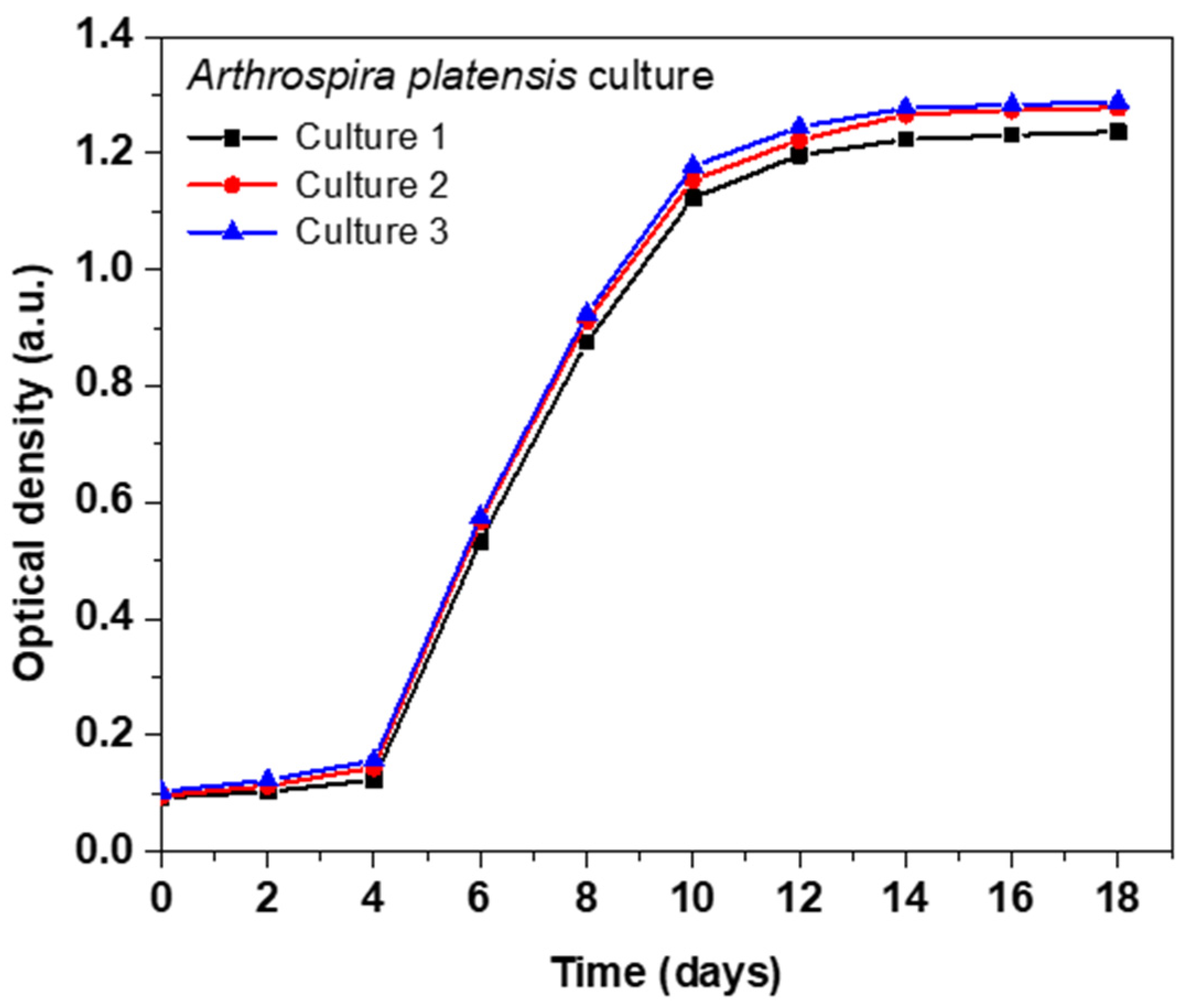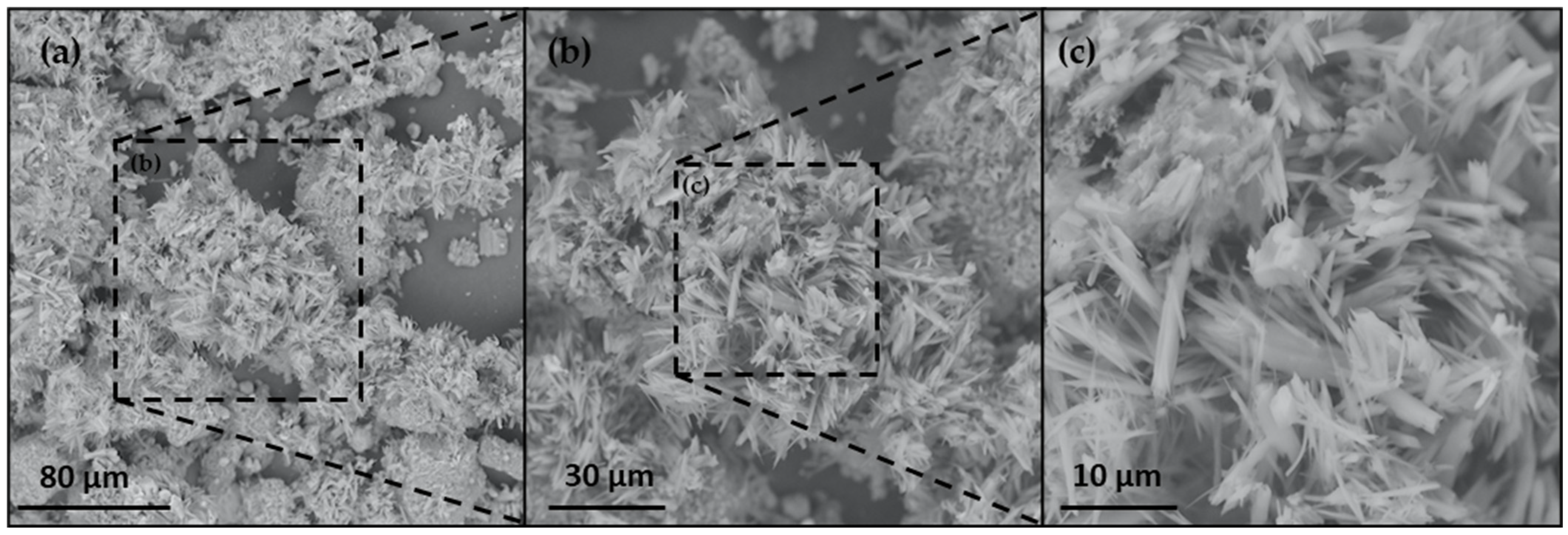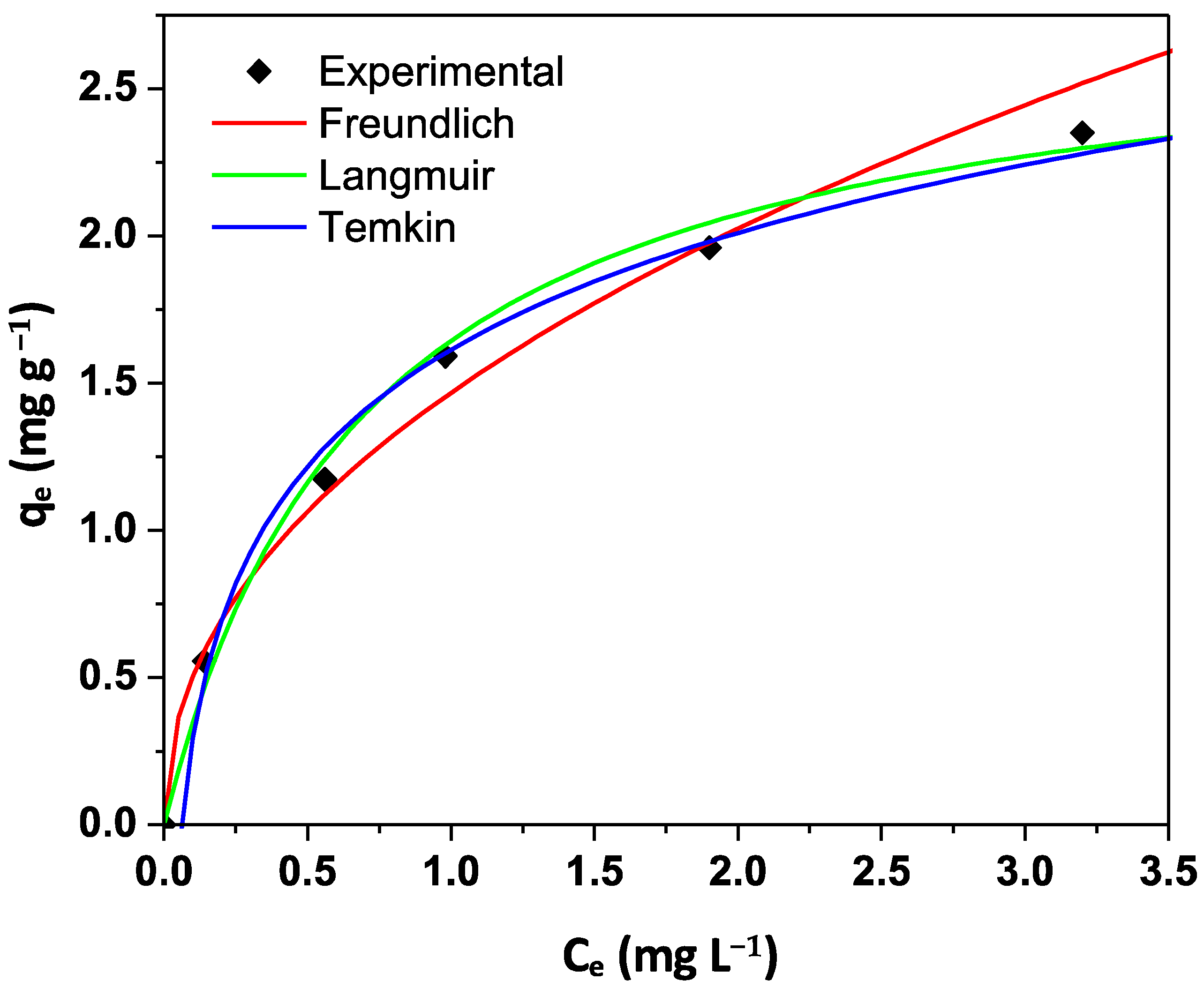Phosphate Removal from Water by Using Biomass Obtained from Arthrospira platensis
Abstract
1. Introduction
2. Materials and Methods
2.1. A. platensis Cultivation and Biomass Extraction
2.2. Phosphorus Adsorption Study onto Biomass
3. Results and Discussions
3.1. Arthrospira Platensis Growth Curve
3.2. Spectroscopic Characterization
3.3. Morphological Characterization
3.4. Adsorption Study
3.5. Kinetic Study
3.6. Isothermal Study
| Sorbent Material | Adsorption Capacity (mg g−1) 1 | Isothermal Model | Kinetic Model |
|---|---|---|---|
| Biochar cyanobacteria [31] | 5.5 | Langmuir | SS |
| Biochar pineapple [48] | 3.7 | Langmuir | SS 2 |
| Biochar/sewage sludge [54] | 0.7–1.2 | NR 3 | NR |
| Biochar/pine sawdust [55] | 2.0 | NR | NR |
| Fe-biochar modified [56] | 0.56 | NR | NR |
| Iron-loaded tannin gel [57] | 2.7 | Freundlich | NR |
| Cyanobacteria biomass (this work) | 2.8 | Langmuir | SS |
4. Conclusions
Author Contributions
Funding
Institutional Review Board Statement
Informed Consent Statement
Data Availability Statement
Acknowledgments
Conflicts of Interest
References
- Akinnawo, S.O. Eutrophication: Causes, consequences, physical, chemical and biological techniques for mitigation strategies. Environ. Chall. 2023, 12, 100733. [Google Scholar] [CrossRef]
- McDowell, R.W.; Luo, D.; Pletnyakov, P.; Upsdell, M.; Dodds, W.K. Anthropogenic nutrient inputs cause excessive algal growth for nearly half the world’s population. Nat. Commun. 2025, 16, 1830. [Google Scholar] [CrossRef] [PubMed]
- Scholz, M.J.; Obenour, D.R.; Morrison, E.S.; Elser, J.J. A critical eutrophication–climate change link. Nat. Sustain. 2025, 8, 222–223. [Google Scholar] [CrossRef]
- Amorim, C.A.; Moura, A. do N. Ecological impacts of freshwater algal blooms on water quality, plankton biodiversity, structure, and ecosystem functioning. Sci. Total Environ. 2021, 758, 143605. [Google Scholar] [CrossRef] [PubMed]
- Nadagouda, M.N.; Varshney, G.; Varshney, V.; Hejase, C.A. Recent Advances in Technologies for Phosphate Removal and Recovery: A Review. ACS Environ. Au 2024, 4, 271. [Google Scholar] [CrossRef]
- Ping, Q.; Zhang, Z.; Guo, W.; Wang, L.; Li, Y. A comprehensive investigation to the fate of phosphorus in full-scale wastewater treatment plants using aluminum salts for enhanced phosphorus removal. Sci. Total Environ. 2024, 913, 169641. [Google Scholar] [CrossRef]
- Li, J.; Wang, Y.; Zhuang, M.; Xu, H.; Cao, W.; Li, F.; Liao, X.; Zhou, Z.; Wang, D. Investigation of the phosphorus removal performance and mechanism of aluminum-based phosphorus-locking agent in enhanced bioretention facility. Urban Water J. 2025, 77, 108483. [Google Scholar] [CrossRef]
- Kuzin, E. Synthesis and Use of Complex Titanium-Containing Coagulant in Water Purification Processes. Inorganics 2025, 13, 9. [Google Scholar] [CrossRef]
- Lin, H.; Wang, Y.; Dong, Y. A review of methods, influencing factors and mechanisms for phosphorus recovery from sewage and sludge from municipal wastewater treatment plants. J. Environ. Chem. Eng. 2024, 12, 111657. [Google Scholar] [CrossRef]
- Wilfert, P.; Kumar, P.S.; Korving, L.; Witkamp, G.J.; Van Loosdrecht, M.C.M. The Relevance of Phosphorus and Iron Chemistry to the Recovery of Phosphorus from Wastewater: A Review. Environ. Sci. Technol. 2015, 49, 9400–9414. [Google Scholar] [CrossRef]
- Kumari, S.; Dong, Y. Alcan-based adsorption: Mitigating phosphate pollution in subsurface drainage water. J. Water Process Eng. 2025, 69, 106781. [Google Scholar] [CrossRef]
- Abdoli, S.; Asgari Lajayer, B.; Dehghanian, Z.; Bagheri, N.; Vafaei, A.H.; Chamani, M.; Rani, S.; Lin, Z.; Shu, W.; Price, G.W. A Review of the Efficiency of Phosphorus Removal and Recovery from Wastewater by Physicochemical and Biological Processes: Challenges and Opportunities. Water 2024, 16, 2507. [Google Scholar] [CrossRef]
- Diaz, R.; Mackey, B.; Chadalavada, S.; Kainthola, J.; Heck, P.; Goel, R. Enhanced Bio-P removal: Past, present, and future—A comprehensive review. Chemosphere 2022, 309, 136518. [Google Scholar] [CrossRef] [PubMed]
- Usman, M.O.; Aturagaba, G.; Ntale, M.; Nyakairu, G.W. A review of adsorption techniques for removal of phosphates from wastewater. Water Sci. Technol. 2022, 86, 3113–3132. [Google Scholar] [CrossRef] [PubMed]
- Rathi, B.S.; Kumar, P.S. Application of adsorption process for effective removal of emerging contaminants from water and wastewater. Environ. Pollut. 2021, 280, 116995. [Google Scholar] [CrossRef]
- Recepoglu, Y.K.; Goren, A.Y.; Orooji, Y.; Khataee, A. Carbonaceous materials for removal and recovery of phosphate species: Limitations, successes and future improvement. Chemosphere 2022, 287, 132177. [Google Scholar] [CrossRef]
- Pesendorfer, S.; Ellersdorfer, M. Kinetics of simultaneous ammonium and phosphate recovery by natural zeolite. ChemEngineering 2021, 5, 68. [Google Scholar] [CrossRef]
- Bao, T.; Damtie, M.M.; yan Wang, C.; Chen, Z.; Tao, Q.; Wei, W.; Cho, K.; Yuan, P.; Frost, R.L.; Ni, B.J. Comprehensive review of modified clay minerals for phosphate management and future prospects. J. Clean. Prod. 2024, 447, 141425. [Google Scholar] [CrossRef]
- Keyikoglu, R.; Khataee, A.; Yoon, Y. Layered double hydroxides for removing and recovering phosphate: Recent advances and future directions. Adv. Colloid Interface Sci. 2022, 300, 102598. [Google Scholar] [CrossRef]
- Singh, S.K.; Yadav, N.; Yadav, P.; Shukla, L.; Pradhan, T.; Kumar, M.; Singh, R.; Kumar, A. Cyanobacterial based bioremediation of xenobiotics compounds. Adv. Chem. Pollution, Environ. Manag. Prot. 2025, 12, 507–524. [Google Scholar]
- Diaz-Uribe, C.; Angulo, B.; Patiño, K.; Hernández, V.; Vallejo, W.; Gallego-Cartagena, E.; Romero Bohórquez, A.R.; Zarate, X.; Schott, E. Cyanobacterial Biomass as a Potential Biosorbent for the Removal of Recalcitrant Dyes from Water. Water 2021, 13, 3176. [Google Scholar] [CrossRef]
- Pan, W.; Xie, H.; Zhou, Y.; Wu, Q.; Zhou, J.; Guo, X. Simultaneous adsorption removal of organic and inorganic phosphorus from discharged circulating cooling water on biochar derived from agricultural waste. J. Clean. Prod. 2023, 383, 135496. [Google Scholar] [CrossRef]
- Yang, S.; Katuwal, S.; Zheng, W.; Sharma, B.; Cooke, R. Capture and recover dissolved phosphorous from aqueous solutions by a designer biochar: Mechanism and performance insights. Chemosphere 2021, 274, 129717. [Google Scholar] [CrossRef] [PubMed]
- Liao, Y.; Chen, S.; Zheng, Q.; Huang, B.; Zhang, J.; Fu, H.; Gao, H. Removal and recovery of phosphorus from solution by bifunctional biochar. Inorg. Chem. Commun. 2022, 139, 109341. [Google Scholar] [CrossRef]
- Li, B.; Jing, F.; Hu, Z.; Liu, Y.; Xiao, B.; Guo, D. Simultaneous recovery of nitrogen and phosphorus from biogas slurry by Fe-modified biochar. J. Saudi Chem. Soc. 2021, 25, 101213. [Google Scholar] [CrossRef]
- Kumari, S.; Dong, Y.; Safferman, S.I. Phosphorus adsorption and recovery from waste streams using biochar: Review of mechanisms, modifications, and agricultural applications. Appl. Water Sci. 2025, 15, 162. [Google Scholar] [CrossRef]
- Michalak, I.; Mironiuk, M.; Godlewska, K.; Trynda, J.; Marycz, K. Arthrospira (Spirulina) platensis: An effective biosorbent for nutrients. Process Biochem. 2020, 88, 129–137. [Google Scholar] [CrossRef]
- Mitrogiannis, D.; Markou, G.; Çelekli, A.; Bozkurt, H. Biosorption of methylene blue onto Arthrospira platensis biomass: Kinetic, equilibrium and thermodynamic studies. J. Environ. Chem. Eng. 2015, 3, 670–680. [Google Scholar] [CrossRef]
- Markou, G.; Mitrogiannis, D.; Çelekli, A.; Bozkurt, H.; Georgakakis, D.; Chrysikopoulos, C.V. Biosorption of Cu2+ and Ni2+ by Arthrospira platensis with different biochemical compositions. Chem. Eng. J. 2015, 259, 806–813. [Google Scholar] [CrossRef]
- Alprol, A.E.; Khedawy, M.; Ashour, M.; Thabet, W.M. Arthrospira platensis nanoparticle-based approach for efficient removal of methyl orange dye from aqueous solutions: Isotherm, kinetic, and thermodynamic analysis. Biomass Convers. Biorefinery 2023, 14, 30279–30296. [Google Scholar] [CrossRef]
- Diaz-Uribe, C.; Monterrosa, F.; Simons, V.; Duran, F.; Florian, V.; Vallejo, W.; Castellanos, K.; Diosa, J.E.; Mosquera-Vargas, E. Phosphorus Removal from Aqueous Solutions Using Biochar Derived from Cyanobacterial Biomass. Water 2025, 17, 1287. [Google Scholar] [CrossRef]
- Sinha, E.; Michalak, A.M.; Balaji, V. Eutrophication will increase during the 21st century as a result of precipitation changes. Science 2017, 357, 405–408. [Google Scholar] [CrossRef] [PubMed]
- Camacho-Fernández, C.; Hervás, D.; Rivas-Sendra, A.; Marín, M.P.; Seguí-Simarro, J.M. Comparison of six different methods to calculate cell densities. Plant Methods 2018, 14, 30. [Google Scholar] [CrossRef] [PubMed]
- Zhou, L.; Xu, D.; Li, Y.; Pan, Q.; Wang, J.; Xue, L.; Howard, A. Phosphorus and Nitrogen Adsorption Capacities of Biochars Derived from Feedstocks at Different Pyrolysis Temperatures. Water 2019, 11, 1559. [Google Scholar] [CrossRef]
- Diaz-Uribe, C.; Walteros, L.; Duran, F.; Vallejo, W.; Romero Bohórquez, A.R. Prosopis juliflora Seed Waste as Biochar for the Removal of Blue Methylene: A Thermodynamic and Kinetic Study. ACS Omega 2022, 7, 42916–42925. [Google Scholar] [CrossRef]
- Sergeeva, Y.E.; Sukhinov, D.V. Influence of Inoculum Age on the Growth and C-Phycocyanin Accumulation in Arthrospira platensis Cyanobacteria. Nanobiotechnol. Rep. 2023, 18, 33–38. [Google Scholar] [CrossRef]
- Dean, A.P.; Sigee, D.C.; Estrada, B.; Pittman, J.K. Using FTIR spectroscopy for rapid determination of lipid accumulation in response to nitrogen limitation in freshwater microalgae. Bioresour. Technol. 2010, 101, 4499–4507. [Google Scholar] [CrossRef]
- Grace, C.E.E.; Lakshmi, P.K.; Meenakshi, S.; Vaidyanathan, S.; Srisudha, S.; Mary, M.B. Biomolecular transitions and lipid accumulation in green microalgae monitored by FTIR and Raman analysis. Spectrochim. Acta Part A Mol. Biomol. Spectrosc. 2020, 224, 117382. [Google Scholar]
- Ghorbani, E.; Nowruzi, B.; Nezhadali, M.; Hekmat, A. Metal removal capability of two cyanobacterial species in autotrophic and mixotrophic mode of nutrition. BMC Microbiol. 2022, 22, 58. [Google Scholar] [CrossRef]
- Huang, W.E.; Griffiths, R.I.; Thompson, I.P.; Bailey, M.J.; Whiteley, A.S. Raman microscopic analysis of single microbial cells. Anal. Chem. 2004, 76, 4452–4458. [Google Scholar] [CrossRef]
- Kuhar, N.; Sil, S.; Umapathy, S. Potential of Raman spectroscopic techniques to study proteins. Spectrochim. Acta Part A Mol. Biomol. Spectrosc. 2021, 258, 119712. [Google Scholar] [CrossRef] [PubMed]
- Peterson, S.C.; Kim, S.; Adkins, J. Surface Charge Effects on Adsorption of Solutes by Poplar and Elm Biochars. C 2021, 7, 11. [Google Scholar] [CrossRef]
- Owodunni, A.A.; Ismail, S.; Kurniawan, S.B.; Ahmad, A.; Imron, M.F.; Abdullah, S.R.S. A review on revolutionary technique for phosphate removal in wastewater using green coagulant. J. Water Process Eng. 2023, 52, 103573. [Google Scholar] [CrossRef]
- Benjelloun, M.; Miyah, Y.; Akdemir Evrendilek, G.; Zerrouq, F.; Lairini, S. Recent Advances in Adsorption Kinetic Models: Their Application to Dye Types. Arab. J. Chem. 2021, 14, 103031. [Google Scholar] [CrossRef]
- Manawi, Y.; Al-Gaashani, R.; Simson, S.; Tong, Y.; Lawler, J.; Kochkodan, V. Adsorptive removal of phosphate from water with biochar from acacia tree modified with iron and magnesium oxides. Sci. Rep. 2024, 14, 17414. [Google Scholar] [CrossRef]
- Qin, Y.; Wu, X.; Huang, Q.; Beiyuan, J.; Wang, J.; Liu, J.; Yuan, W.; Nie, C.; Wang, H. Phosphate Removal Mechanisms in Aqueous Solutions by Three Different Fe-Modified Biochars. Int. J. Environ. Res. Public Health 2023, 20, 326. [Google Scholar] [CrossRef]
- Al-Ghouti, M.A.; Da’ana, D.A. Guidelines for the use and interpretation of adsorption isotherm models: A review. J. Hazard. Mater. 2020, 393, 122383. [Google Scholar] [CrossRef]
- Liao, T.; Li, T.; Su, X.; Yu, X.; Song, H.; Zhu, Y.; Zhang, Y. La(OH)3-modified magnetic pineapple biochar as novel adsorbents for efficient phosphate removal. Bioresour. Technol. 2018, 263, 207–213. [Google Scholar] [CrossRef]
- Zhang, H.; Chen, C.; Gray, E.M.; Boyd, S.E.; Yang, H.; Zhang, D. Roles of biochar in improving phosphorus availability in soils: A phosphate adsorbent and a source of available phosphorus. Geoderma 2016, 276, 1–6. [Google Scholar] [CrossRef]
- Luo, D.; Wang, L.; Nan, H.; Cao, Y.; Wang, H.; Kumar, T.V.; Wang, C. Phosphorus adsorption by functionalized biochar: A review. Environ. Chem. Lett. 2022, 21, 497–524. [Google Scholar] [CrossRef]
- Mari Selvam, S.; Behera, B.; Chauhan, A.; Madaan, A.; Rajamanickam, R.; Akshaya, K.; Selvasembian, R. Sustainable approach of modified biochar based adsorbents towards enhanced phosphorus removal from wastewater. J. Anal. Appl. Pyrolysis 2025, 188, 107020. [Google Scholar] [CrossRef]
- Jung, K.W.; Hwang, M.J.; Ahn, K.H.; Ok, Y.S. Kinetic study on phosphate removal from aqueous solution by biochar derived from peanut shell as renewable adsorptive media. Int. J. Environ. Sci. Technol. 2015, 12, 3363–3372. [Google Scholar] [CrossRef]
- Zhu, Z.; Huang, C.P.; Zhu, Y.; Wei, W.; Qin, H. A hierarchical porous adsorbent of nano-α-Fe2O3/Fe3O4 on bamboo biochar (HPA-Fe/C-B) for the removal of phosphate from water. J. Water Process Eng. 2018, 25, 96–104. [Google Scholar] [CrossRef]
- Melia, P.M.; Busquets, R.; Hooda, P.S.; Cundy, A.B.; Sohi, S.P. Driving forces and barriers in the removal of phosphorus from water using crop residue, wood and sewage sludge derived biochars. Sci. Total Environ. 2019, 675, 623–631. [Google Scholar] [CrossRef] [PubMed]
- Lou, K.; Rajapaksha, A.U.; Ok, Y.S.; Chang, S.X. Pyrolysis temperature and steam activation effects on sorption of phosphate on pine sawdust biochars in aqueous solutions. Chem. Speciat. Bioavailab. 2016, 28, 42–50. [Google Scholar] [CrossRef]
- Liu, F.; Zuo, J.; Chi, T.; Wang, P.; Yang, B. Removing phosphorus from aqueous solutions by using iron-modified corn straw biochar. Front. Environ. Sci. Eng. 2015, 9, 1066–1075. [Google Scholar] [CrossRef]
- Ogata, T.; Morisada, S.; Oinuma, Y.; Seida, Y.; Nakano, Y. Preparation of adsorbent for phosphate recovery from aqueous solutions based on condensed tannin gel. J. Hazard. Mater. 2011, 192, 698–703. [Google Scholar] [CrossRef]






| Model | Linear Equation * | Equation Description |
|---|---|---|
| Pseudo-first order (PFO) | adsorption capacity at equilibrium, t is time, and k1 is the rate constant (min−1). | |
| Pseudo-second order (PSO) | is the equilibrium adsorption capacity and k2 is the rate constant (g·mg−1·min−1). | |
| Intraparticle diffusion | kid is the rate constant (g·mg−1min min−1/2) and c is constant (mg·g−1) |
| Model | Parameters | ||
| PFO | qe (mg·g−1) 2.8 | k1 (min−1) 1.41 | R2 0.9519 |
| PSO | qe (mg·g) 2.5 | k2 (g/(mg·min)) 0.233 | R2 0.998 |
| Intraparticle diffusion | C mg·g−1 1.09 | Kid (g/mg·min) 0.273 | R2 0.716 |
| Model | Linear Equation * | Equation Description |
|---|---|---|
| Langmuir | is the adsorption capacity at equilibrium, t is time, and kL is constant of model (L·mg−1). Ce is (is the equilibrium concentration of phosphate (mg·L−1). | |
| Freundlich | KF is constant of model ((mg·g−1)(L·mg−1)1/n) and n is a constant associated with heterogeneity of the surface. | |
| Temkin | B is the constant of the model and AT is a constant associated with equilibrium anchoring (L·mg−1). |
| Model | Parameters | ||
|---|---|---|---|
| Langmuir | qmax (mg/g) 2.8 | KL (L·mg−1) 1.41 | R2 0.992 |
| Freundlich | KF(mg·g−1)(L·mg−1)1/n. 1.47 | 1/n 0.46 | R2 0.986 |
| Temkin | Bt (L·mg−1) 0.57 | KT (L·g−1) 16.7 | R2 0.988 |
Disclaimer/Publisher’s Note: The statements, opinions and data contained in all publications are solely those of the individual author(s) and contributor(s) and not of MDPI and/or the editor(s). MDPI and/or the editor(s) disclaim responsibility for any injury to people or property resulting from any ideas, methods, instructions or products referred to in the content. |
© 2025 by the authors. Licensee MDPI, Basel, Switzerland. This article is an open access article distributed under the terms and conditions of the Creative Commons Attribution (CC BY) license (https://creativecommons.org/licenses/by/4.0/).
Share and Cite
Barrios, Y.; Diaz-Uribe, C.; Vallejo, W.; Diosa, J.E.; Mosquera-Vargas, E. Phosphate Removal from Water by Using Biomass Obtained from Arthrospira platensis. Sci 2025, 7, 133. https://doi.org/10.3390/sci7030133
Barrios Y, Diaz-Uribe C, Vallejo W, Diosa JE, Mosquera-Vargas E. Phosphate Removal from Water by Using Biomass Obtained from Arthrospira platensis. Sci. 2025; 7(3):133. https://doi.org/10.3390/sci7030133
Chicago/Turabian StyleBarrios, Yuleiny, Carlos Diaz-Uribe, William Vallejo, Jesús E. Diosa, and Edgar Mosquera-Vargas. 2025. "Phosphate Removal from Water by Using Biomass Obtained from Arthrospira platensis" Sci 7, no. 3: 133. https://doi.org/10.3390/sci7030133
APA StyleBarrios, Y., Diaz-Uribe, C., Vallejo, W., Diosa, J. E., & Mosquera-Vargas, E. (2025). Phosphate Removal from Water by Using Biomass Obtained from Arthrospira platensis. Sci, 7(3), 133. https://doi.org/10.3390/sci7030133







